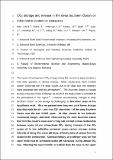Files in this item
CO2 storage and release in the deep Southern Ocean on millennial to centennial timescales
Item metadata
| dc.contributor.author | Rae, James W. B. | |
| dc.contributor.author | Burke, Andrea | |
| dc.contributor.author | Robinson, L. F. | |
| dc.contributor.author | Adkins, J. F. | |
| dc.contributor.author | Chen, T. | |
| dc.contributor.author | Cole, C. | |
| dc.contributor.author | Greenop, Rosanna | |
| dc.contributor.author | Li, T. | |
| dc.contributor.author | Littley, E. | |
| dc.contributor.author | Nita, D. C. | |
| dc.contributor.author | Stewart, J. A. | |
| dc.contributor.author | Taylor, B. | |
| dc.date.accessioned | 2019-04-23T23:37:44Z | |
| dc.date.available | 2019-04-23T23:37:44Z | |
| dc.date.issued | 2018-10-25 | |
| dc.identifier | 256073240 | |
| dc.identifier | 37bc72fa-994e-4cb7-a1f1-f41c490fb743 | |
| dc.identifier | 000448277800054 | |
| dc.identifier | 85055416640 | |
| dc.identifier | 000448277800054 | |
| dc.identifier.citation | Rae , J W B , Burke , A , Robinson , L F , Adkins , J F , Chen , T , Cole , C , Greenop , R , Li , T , Littley , E , Nita , D C , Stewart , J A & Taylor , B 2018 , ' CO 2 storage and release in the deep Southern Ocean on millennial to centennial timescales ' , Nature , vol. 562 , pp. 569-573 . https://doi.org/10.1038/s41586-018-0614-0 | en |
| dc.identifier.issn | 0028-0836 | |
| dc.identifier.other | ORCID: /0000-0003-3904-2526/work/60196323 | |
| dc.identifier.other | ORCID: /0000-0002-3754-1498/work/64034555 | |
| dc.identifier.other | ORCID: /0000-0003-1442-7585/work/75997018 | |
| dc.identifier.uri | https://hdl.handle.net/10023/17585 | |
| dc.description | This work was supported by NERC Standard Grant NE/N003861/1 to J.W.B.R. and L.F.R., a NOAA Climate and Global Change VSP Fellowship to J.W.B.R, NERC Standard Grant NE/M004619/1 to AB and JWBR, a NERC Strategic Environmental Science Capital Grant to A.B. and J.W.B.R., Marie Curie Career Integration Grant CIG14-631752 to AB, an ERC consolidator grant to L.F.R., NSF grant OCE-1503129 to J.F.A., and NERC studentships to B.T. and E.L. | en |
| dc.description.abstract | The cause of changes in atmospheric carbon dioxide (CO2) during the recent ice ages is yet to be fully explained. Most mechanisms for glacial–interglacial CO2 change have centred on carbon exchange with the deep ocean, owing to its large size and relatively rapid exchange with the atmosphere1. The Southern Ocean is thought to have a key role in this exchange, as much of the deep ocean is ventilated to the atmosphere in this region2. However, it is difficult to reconstruct changes in deep Southern Ocean carbon storage, so few direct tests of this hypothesis have been carried out. Here we present deep-sea coral boron isotope data that track the pH—and thus the CO2 chemistry—of the deep Southern Ocean over the past forty thousand years. At sites closest to the Antarctic continental margin, and most influenced by the deep southern waters that form the ocean’s lower overturning cell, we find a close relationship between ocean pH and atmospheric CO2: during intervals of low CO2, ocean pH is low, reflecting enhanced ocean carbon storage; and during intervals of rising CO2, ocean pH rises, reflecting loss of carbon from the ocean to the atmosphere. Correspondingly, at shallower sites we find rapid (millennial- to centennial-scale) decreases in pH during abrupt increases in CO2, reflecting the rapid transfer of carbon from the deep ocean to the upper ocean and atmosphere. Our findings confirm the importance of the deep Southern Ocean in ice-age CO2 change, and show that deep-ocean CO2 release can occur as a dynamic feedback to rapid climate change on centennial timescales. | |
| dc.format.extent | 16 | |
| dc.format.extent | 2194176 | |
| dc.language.iso | eng | |
| dc.relation.ispartof | Nature | en |
| dc.subject | GE Environmental Sciences | en |
| dc.subject | GC Oceanography | en |
| dc.subject | DAS | en |
| dc.subject | BDC | en |
| dc.subject | R2C | en |
| dc.subject | SDG 13 - Climate Action | en |
| dc.subject.lcc | GE | en |
| dc.subject.lcc | GC | en |
| dc.title | CO2 storage and release in the deep Southern Ocean on millennial to centennial timescales | en |
| dc.type | Journal item | en |
| dc.contributor.sponsor | NERC | en |
| dc.contributor.sponsor | NERC | en |
| dc.contributor.sponsor | NERC | en |
| dc.contributor.sponsor | European Commission | en |
| dc.contributor.institution | University of St Andrews. School of Earth & Environmental Sciences | en |
| dc.contributor.institution | University of St Andrews. St Andrews Isotope Geochemistry | en |
| dc.identifier.doi | 10.1038/s41586-018-0614-0 | |
| dc.description.status | Peer reviewed | en |
| dc.date.embargoedUntil | 2019-04-24 | |
| dc.identifier.grantnumber | NE/N003861/1 | en |
| dc.identifier.grantnumber | NE/M004619/1 | en |
| dc.identifier.grantnumber | CC082 | en |
| dc.identifier.grantnumber | PCIG14-GA-2013-631752 | en |
This item appears in the following Collection(s)
Items in the St Andrews Research Repository are protected by copyright, with all rights reserved, unless otherwise indicated.

